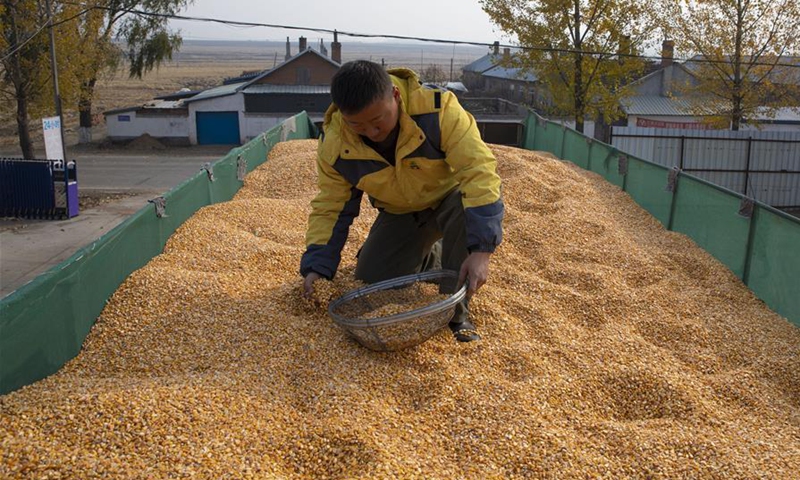
A worker examines corns in Ning'an City, northeast China's Heilongjiang Province, Oct. 27, 2020. (Xinhua/Zhang Tao)
Russia's exports of corn, for which China has skyrocketing demand, may rise in the coming years with the country's huge output potential, warm political relations and logistics advantages, a major Chinese grain importer told the Global Times on Wednesday.
While China's reliance on imported soybeans gets more attention, the level of import reliance on a number of other grain crops is staggering.
China has imported so much corn and wheat that the agriculture ministry issued a notice to promote animal feed formulas that incorporate more domestic grain.
Gao Jianyi, a procurement manager with Xiamen C&D Commodities, said he believed that Russian corn could reach one-quarter of the current import volume of US corn, rising from zero just a few years ago.
In 2019, Xiamen C&D Commodities began to import Russian soybeans, wheat and corn to further diversify its sources for the sake of reducing political risks and avoiding infrastructure bottlenecks.
"Russian grain has huge demand in the Chinese market," Gao said. "In three or five years, the import volume could reach the 1-million-ton threshold, or 25 percent of the current level of imports from the US."
In 2020, China imported 11.3 million tons of corn, up 135.7 percent year-on-year. Gao said that among the imports, 6.3 million tons came from Ukraine and 4.3 million tons from the US, citing data. Imports from Russia stood at 130,000 tons.
Corn is used to make ethanol, starch and sugar in China. Corn imported from the US is genetically modified and used to make animal feed, according to Chinese regulations.
The Port of Zarubino, a Russian Far East port with a modest throughput capacity that is only a fraction of its peers in China, and one that can only receive ships displacing 10,000 tons or less, has become a bottleneck for Far East grain.
"The port's handling capacity is a choke point in the China-Russia grain trade flow," Gao said. "It takes days to handle what Chinese ports can handle in a matter of hours."
The other setback is that Russian farms in the Far East are not used to using futures contracts, a business model that has become commonplace in China.
"These two drawbacks aside, Russia really serves as a key alternative for China's grain import diversification," Gao noted. "The low per ton cost of Russian grain and the big trend in Belt and Road Initiative cooperation will provide growth impetus."
Russian Foreign Minister Sergei Lavrov visited China earlier this week, and the two countries are seeking to improve their economic and trade ties to ensure security. The top Russian diplomat called for reducing the risks of US sanctions by promoting trade settlements using local and other international currencies.



